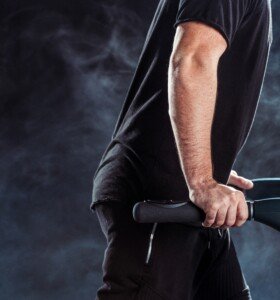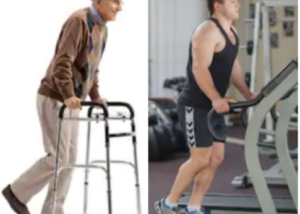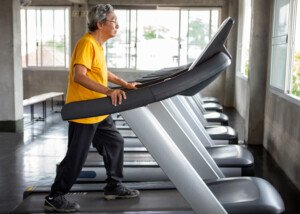
If you try to walk with “good posture” holding onto a treadmill, this is still bad for the spine – even if your posture seems to be perfect throughout the entire session.
“Holding onto guardrails or handles while using a treadmill can pose difficulties, not only from a postural standpoint, but also in terms of how the body propels itself with natural motion,” says Ali H. Mesiwala, MD, a board certified neurosurgeon with DISC Sports & Spine Center in Newport Beach, CA.
“Grabbing onto handrails and trying to maintain a normal posture causes the spine to be flexed forward and alters the normal and ideal curvature needed for efficient movement.
“This causes additional strain on the sacroiliac joints and prevents full excursion of the iliopsoas muscle [a major hip flexor] and proper form in terms of running or walking.
“In addition, by shifting the center of gravity forward, additional stress is placed on the lumbar spine and the thoracic spine.”
Even if you make an effort to keep as erect as possible, you may unknowingly lose this form at some point during your walking.
Furthermore, even if, from a positional standpoint, your posture is “good” – meaning, upright rather than leaning forward – your spine and hips are not working the way nature intended them to.
If you’re walking hands-free, you don’t have to think about maintaining good posture, because it will come naturally as your body is forced to stay balanced (which requires good posture) while walking on a moving surface below the feet.
In short, walking without holding onto a treadmill forces the body into optimal posture, though this won’t correct abnormal curvatures of the spine that create the illusion of poor posture.
But from a functional standpoint, a hands-off walk means your gait will be natural, with all the structures in your body functioning the way they’re supposed to.
“By holding onto the handles or rails, natural fluidity of gait or running is altered,” says Dr. Mesiwala.
“The arms are normally used in a swinging motion, which is opposite to the movement of the legs, in order to allow for propulsion forward.
“In restraining the use of the arms, the legs are the main drivers of propulsion, and added strain is placed on the iliopsoas muscle, which will, in turn, cause additional stresses on the spine.”
Maintaining Correct Posture While Holding onto a Treadmill
Go ahead, try it. See how long you can keep it up, especially at faster speeds.
A tall person who prefers to hold onto the front bar will often lurch forward because their feet are placed relatively far from the front bar.

Depositphotos.com
Though such an individual may have a normal spine, it will appear that they have spinal stenosis, which causes a forward lean when walking anywhere in life.
If the young man pictured above walked that way around the workplace, people would wonder what was wrong with his lower back.
The extra height forces the person to lean forward in order to keep their hands on the front bar.
A shorter person won’t lean in as much. However, if a short person prefers the palms-on-side-rails approach, this will cause the “shoulder bob” which can lead to shoulder pain hours later.
With each step, their shoulders bob up and down, often forward and backward as well, in unnatural motions.
If the distance from their shoulders to the rails allows for straight arms, the walker will be prone to subtracting weight from their body as they move. This promotes a stiff, rather than relaxed, body.
The straightened, often very locked-out arms, will act as sturdy rods, literally pushing the body upward. I call this a light gravity walk.
So even if the walker maintains a vertical body with no hunching, there are still problems with holding onto the treadmill.
Holding onto a treadmill, regardless of how your body is positioned, regardless of where on the machine you’re holding, and regardless of your height, is an unnatural way to move, and essentially trains your body in using a walker!
I’ve seen very tall men doing the light gravity walk as well, but due to their height, they have the forward lean.
Other Problems with Holding onto a Treadmill Even with Good Posture
- The calorie readout is much inflated because it’s based on the machine settings, not the walker’s physiology. Step off the machine by placing your feet on the platform to straddle the moving tread, and you’ll see that the calorie counter is still counting.
- Holding on locks up the upper body, so even if your body is straight, your hips are still forced to over-rotate, which can lead to hip area pain.
- The foot strike is abnormal.
“When using a treadmill or other elliptical machine, the freedom of movement allowed by not grabbing onto the handrails allows for the intrinsic muscles of the spine to be engaged, which also helps build core musculature and improve stability,” says Dr. Mesiwala.
 Dr. Mesiwala specializes in the development of novel technologies and minimally invasive techniques for spinal and cranial surgery. He’s a fellowship-trained expert in complex spinal procedures, including deformity correction and revision surgery, as well as disc replacement operations, and has performed 8,000+ operations since 2004. drmesiwala.com
Dr. Mesiwala specializes in the development of novel technologies and minimally invasive techniques for spinal and cranial surgery. He’s a fellowship-trained expert in complex spinal procedures, including deformity correction and revision surgery, as well as disc replacement operations, and has performed 8,000+ operations since 2004. drmesiwala.com
 Lorra Garrick has been covering medical, fitness and cybersecurity topics for many years, having written thousands of articles for print magazines and websites, including as a ghostwriter. She’s also a former ACE-certified personal trainer.
Lorra Garrick has been covering medical, fitness and cybersecurity topics for many years, having written thousands of articles for print magazines and websites, including as a ghostwriter. She’s also a former ACE-certified personal trainer.
.


























